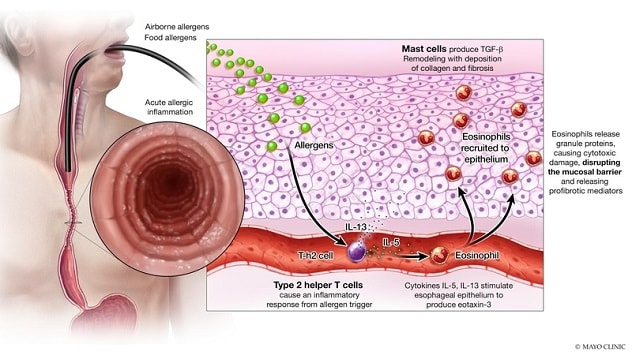Jan. 11, 2024
Eosinophilic esophagitis

Eosinophilic esophagitis
Eosinophilic esophagitis is a chronic immune system disease where eosinophil builds up in the lining of the esophagus. It's a reaction to food, allergens or acid reflux that can lead to difficulty swallowing.
Eosinophilic esophagitis (EoE) is a chronic immune system disease where eosinophils build up in the lining of the esophagus. This buildup, which is a reaction to foods, allergens or acid reflux, can inflame or injure the esophageal tissue. Damaged esophageal tissue can lead to difficulty swallowing or cause food to get stuck when swallowing.
Symptoms of EoE in children include:
- Difficulty eating.
- Vomiting.
- Abdominal pain.
- Dysphagia.
- Impaction.
- Failure to thrive, including poor growth, malnutrition and weight loss.
Mayo Clinic Children's Center specialists are skilled in distinguishing EoE from gastroesophageal reflux disease (GERD) and other conditions that may cause similar symptoms. Mayo Clinic doctors diagnose and treat nearly 1,500 adults and children each year who have eosinophilic esophagitis.
"Our multidisciplinary clinic allows for patients to receive a comprehensive evaluation with pediatric gastroenterologists, allergist-immunologists and dietitians," Puanani E. Hopson, D.O., a pediatric gastroenterologist at Mayo Clinic Children's Center in Rochester, Minnesota. "This approach ensures a thorough, individualized management plan for each patient."
Mayo Clinic Children's Center is one of the few centers for children to offer an alternative to traditional esophagoscopies: transnasal endoscopy (TNE). TNE is an upper endoscopy method that is performed by the nasal route using a thin endoscope while the patient is still awake. This alternative procedure doesn't require prolonged fasting, sedation or an IV. It is also less invasive and has a quicker turnaround time — the procedure itself only takes about 10 minutes, and children can typically return to school immediately following the procedure.
"Transnasal endoscopy has been introduced in the care of pediatric patients with eosinophilic esophagitis who require repeated endoscopies," says Dr. Hopson. "TNE avoids sedation or anesthesia, which allows for more-frequent assessment of the esophageal mucosa."
"Lidocaine is used in the nose and the back of the mouth, and virtual reality goggles can be used to watch a movie for a pleasant distraction," says Dr. Hopson.
An evaluation is completed to determine whether a patient is a good candidate for this procedure, and the criteria includes:
- 5 years or older.
- No relevant anatomic abnormalities.
- Cooperative during examinations.
Mayo Clinic is actively involved in research on new diagnostic tools and therapies for EoE, which means that in addition to standard eosinophilic esophagitis therapy a patient can have access to new tools and experimental treatments not available elsewhere.
"My recent research is in artificial intelligence to identify broad histologic markers for EoE to help differentiate it from other diseases," says Dr. Hopson. "The goal of this study was to shed more light on subtle changes in the pathology in patients who have continued symptoms despite improvement in their eosinophil count."
This newly developed artificial intelligence (AI) model, published in the September 2022 issue of Journal of Pathology Informatics, can accurately identify, quantify and score several of the main histopathologic features in the EoE spectrum with agreement regarding Eosinophilic Esophagitis Histologic Scoring System scoring.
"This newly developed AI-based tool showed an excellent performance, and it represents an important step in creating an accurate and reproducible method for semi-automated quantitative analysis to be used in the evaluation of esophageal biopsies," says Dr. Hopson. These performance results were published in the October 2023 issue of Modern Pathology.
Additional research focused on identifying patient factors to help predict the best treatment approach for a patient with EoE. Eosinophil-derived neurotoxin (EDN), an eosinophilic granule protein, measured in esophageal brushing has been shown to be a viable measure of disease activity. In results published in the February 2022 issue of the Journal of Pediatric Gastroenterology and Nutrition, it was found that EDN measured in esophageal epithelial samples obtained by brushing during endoscopy may predict proton pump inhibitor responsiveness in children and young adults with EoE.
"At Mayo Clinic Children's Center, we are pleased to offer a comprehensive and individualized approach for patients with EoE," says Dr. Hopson. "Offering an unsedated option for a procedure that is required in the ongoing management of this disease provides a safe and effective alternative for those who would benefit the most."
For more information
Irastorza LE, et al. Eosinophil-derived neurotoxin predicts response to proton-pump inhibitor treatment in pediatric eosinophilic esophagitis. Journal of Pediatric Gastroenterology and Nutrition. 2022; doi:10.1097/MPG.0000000000003257.
Archila LR, et al. Development and technical validation of an artificial intelligence model for quantitative analysis of histopathologic features of eosinophilic esophagitis. Journal of Pathology Informatics. 2022; doi:10.1016/j.jpi.2022.100144.
Archila LR, et al. Performance of an artificial intelligence model for recognition and quantitation of histologic features of eosinophilic esophagitis on biopsy samples. Modern Pathology. 2023; doi:10.1016/j.modpat.2023.100285.
Refer a patient to Mayo Clinic.